
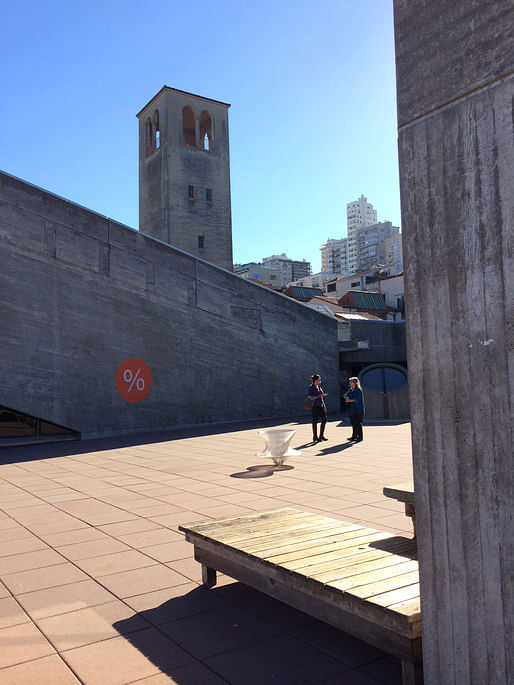
After a glorious lunch in the sun, looking out over the bay, we're back for the first afternoon session. (You can catch up on our morning session here.) (You can also view the full survey results from the Equity in Architecture Survey 2014 here.)

Amber Evans, senior associate at GouldEvans, is introducing the session on negotiation. "If you don't negotiate your salary, the amount of money you will forfeit over your career will likely be over a million dollars." "Don't wait for others to notice and offer things to you."
Laurie Dreyer: There are five personality types in terms of negotiation:


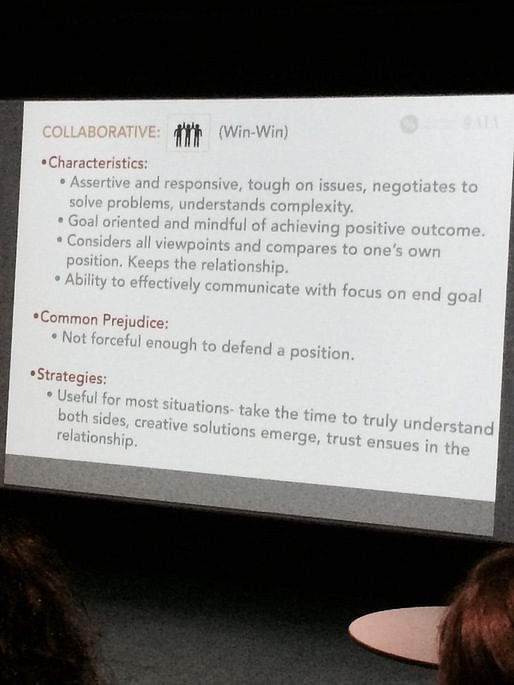
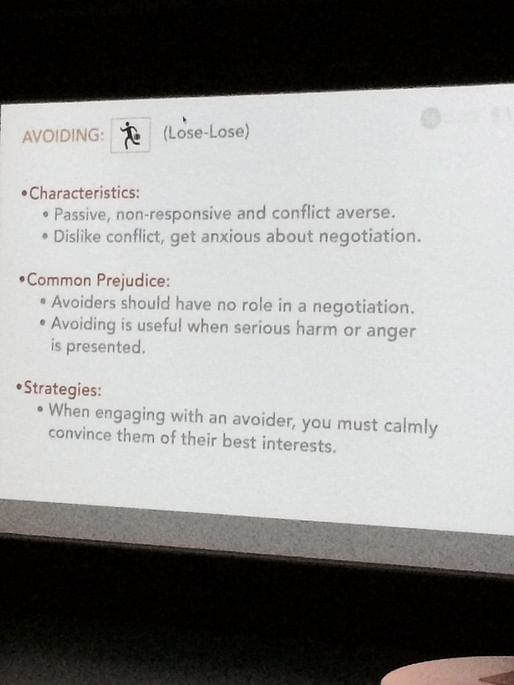
 Designers and architects are most often avoiders and accommodators. "An introverted architect will look at their shoes; an extroverted architect will look at your shoes."
Designers and architects are most often avoiders and accommodators. "An introverted architect will look at their shoes; an extroverted architect will look at your shoes."
The 'competing' type is the most aggressive, and is often represented among client representatives, which can make it hard for architects. But there's a cost to be paid for that style of behavior--you may win in the short term but the relationship may suffer. The way to deal with a competitive style is to match that competitive style.
The collaborative style is "win-win." Rosa Sheng: If people see that you're facilitating a collaborative negotiation, they'll respect you.
Now we're doing a negotiation role-play exercise:
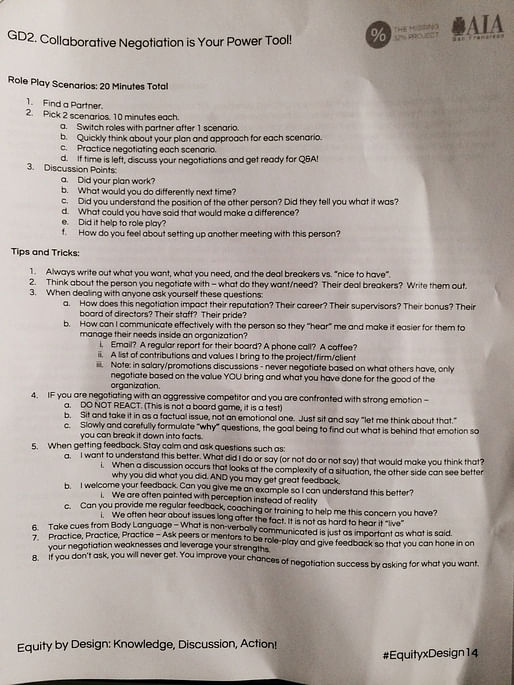
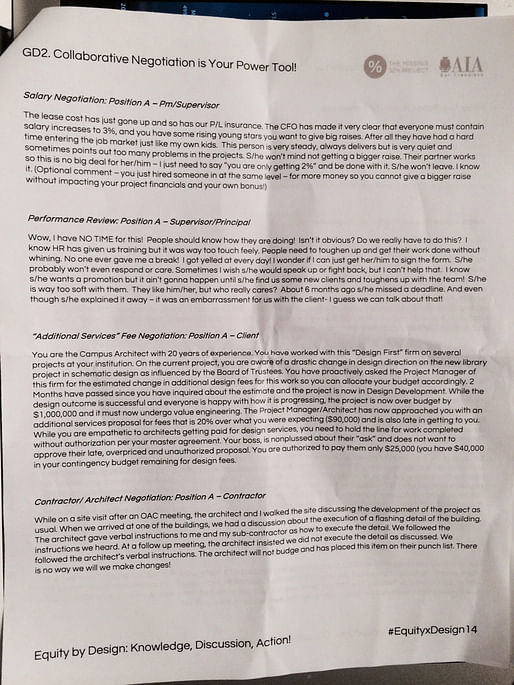

For example: "I've added value in X, Y, Z ways; I keep clients happy and you have moved me up three billing levels. But when I look across other organizations, people in similar roles to me earn a lot more, and that's bothersome to me. I think I'm worth more, particularly when you think about how much it would cost to replace me. I want to stay in this firm." "...What would you do if this were you?"
2:10 pm: Back in the main session. Lilian Asperin Clyman is moderating. Only 41% of men and 28% of women report being satisfied with their architecture jobs.

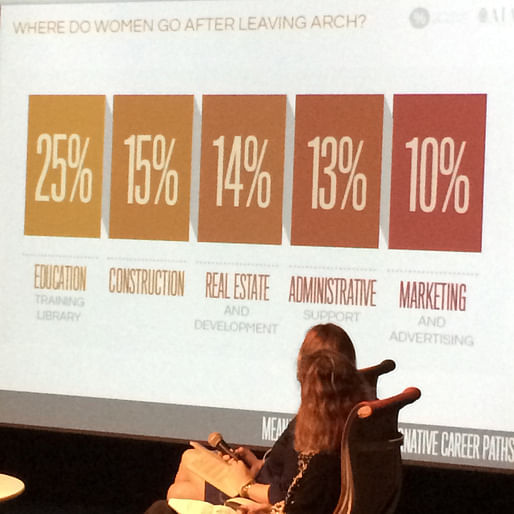
The survey asked both people who had taken leaves and who had not, about the impacts of taking leave. The result is that people who hadn't taken a leave thought the negative impacts would be greater. (It's a self-selecting group, though, because if you think it's going to be rough, you're disincentivized to do it.)
2:17 pm: Beyoncé is mentioned.

2:18 pm: Emily Grandstaff-Rice: I'm an architect because I love problem solving; and because at the end of the day, I need to see the physical results of my work. I love walking into a space that I had a hand in creating.
Karen Liu Staubach is a real estate project executive at Google. "I really valued the soft skills that I gained" in architecture school. Working in the field of architecture, I felt that it was about "here's the work, please produce these drawings." If I asked "what is the project about?" I would be told "I'll tell you later." At Google, KLS is always happy to have more designers at the table in meetings where they, as the client, are talking about what the project means to them and what they need. The more people involved in brainstorming, the better.
2:23 pm: Amy Eliot, principal at Dilworth Eliot: "Your worst reviews in architecture school are the ones you still think about." Sometimes the tough situations are the ones you learn the most from. In school, I remember looking up from my desk and seeing a group of men looking at something, and there would be literally no cracks between them so I'd have to squeeze my way in to see what it was--and that was the 1980s..."
2:25 pm: The new paradigm is more youth-centric. In meetings, we'll often bring a more junior designer and the client will turn to them to ask what they think, because they're the demographic the client is trying to reach.
AE: You have to be willing to give up some of the ownership over your project, and to share that. Our designers, three to five years out of school, work really hard and invest in their work when we do this.
2:43 pm: EGR: "The BSA and AIA allow me to go deeper into topics that I wouldn't otherwise be able to delve into in my day to day. It's a great complement to my work as an architect."
2:45 pm: To make change in your firm: "Do it, and ask forgiveness later." "Invite people to a dialogue: give them a platform to share their point of view."
Coffee Break
3:10 pm: This session is called "Architecture and...(Expanding Influence by way of the Multidisciplinary Practice.)" Christina Cho, Principal at Atelier Cho Thompson, which also produced the new Missing 32% survey data, explains the broad range of services that her two-person firm provides. "The business model has been working--graphic work has often helped us fill in the gaps, and we've also gotten to sit at the table with clients before we otherwise would have."
3:18 pm: Heidi Reinfeld, Partner and Vice President of Creative at San Francisco and New York branding and marketing firm Sequence: "I'm not an architect." "...We have about 65 people. Some of our growth was planned and most of it was organic." In 2008, the iPhone app store launched--and just think, last year there were over a million apps in that store. At the time, we decided to evolve and get into it. It's a hero project--it either takes a client to trust you and give you loads of money; or you take a project and get paid 1/4 of the cost, which sets a bad precedent." "Chipotle was an existing client; we went to them and offered to help them offer pre-ordering on smartphones to help reduce the long lines at their locations."
A few years ago Best Buy needed help--that's another opportunity for a hero project, when a company is failing and wants to make big change. We thought about their total service experience with them--and that's a new vertical for us. As you diversity, think about the industry you're in and how to define the verticals, or expertise that you offer.
Coffee Break! People are adding post-its to a 'Relevancy Chart' to describe what we'd like to see more and less of in the profession. The post-its are color-coded to describe what career stage or direction we're from.
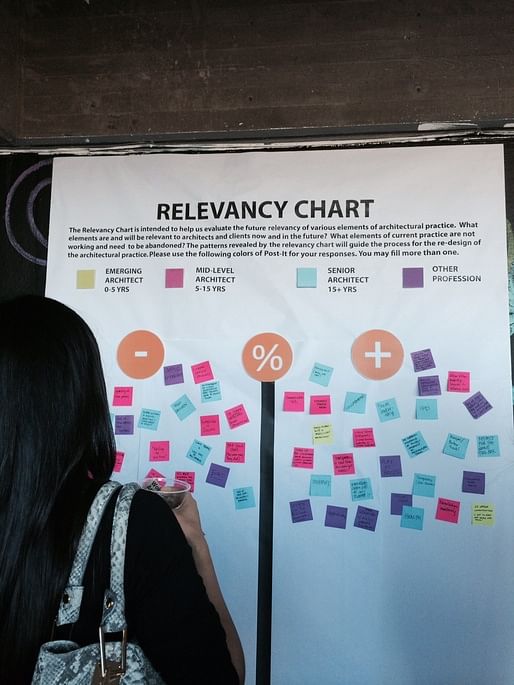
4:06 pm: Stew Friedman, Founder of Total Leadership and Director of the Wharton Work/Life Integration Project, is the guest for the final plenary session. Apparently Friedman leaned in to negotiations for his appearance and the purchase of 250 copies of his new book, Leading the Life You Want for all the symposium attendees became part of the deal. So now we all have copies!
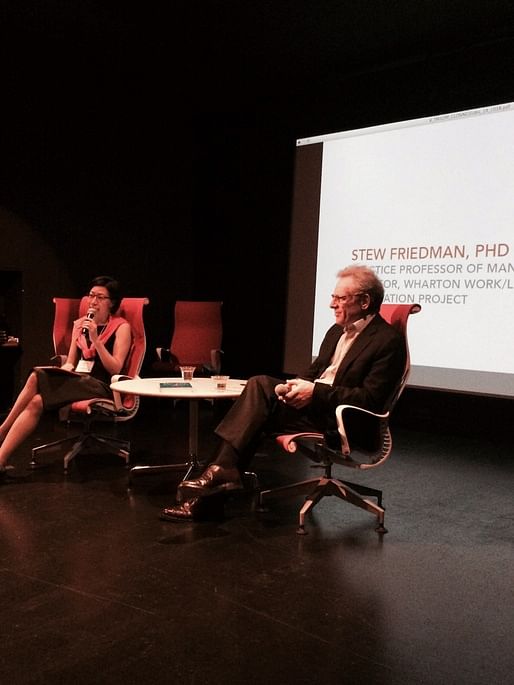
4:11 pm: Rosa Sheng talks about feeling guilt and anxiety about feeling like she couldn't give enough both on the home front and at work, and how Friedman's work helped her.
Friedman's book Baby Bust: New Choices for Men and Women in Work and Family surveyed two cohorts of graduating classes at Wharton. “In 1992, 78% said that they planned to have children. In 2012, 42% did.” The good news is that men's and women's viewpoints converged--that now, men and women are thinking in similar ways to each other.
Total Leadership: Be a Better Leader, Have a Richer Life, Friedman's second book, digs into our lives in four spheres--work, community, family, and private self--to talk about how we can harmonize these areas of our lives instead of thinking about them competing for our attention in a zero-sum game.
The greater the overlap between these four circles, the better off you are. Draw them, including the overlaps. Think about what you can do to bring these spheres into better harmony, with more overlap.
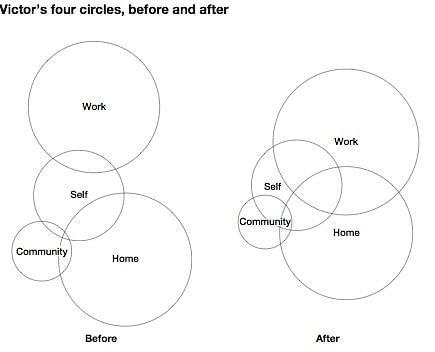
It's not necessarily about making these spheres coincide in time and space; boundaries are important. It's about how our lives in these areas serve our values and goals.
Friedman talks about blocking out time for our different pursuits and holding them sacred--time with children and other loved ones is as important as work appointments.
"I studied prisoners of war. The way they survive in the most constrained context imaginable, is that they find a place in the heads where they have control, and they protect it." You have more control than you think about. It's not just about you, but about the people who matter to you--your colleagues, your family, your friends.
Question from the audience: How do you use this system without feeling like a failure for the ways in which we aren't bringing these together? Friedman: think about a day in your ideal future life, 15 years from now. Talk about this with your colleagues. You learn more about each other. "If your dream is to live in a big house...and make a shit ton of money, nobody's going to care about that. But if your dream is about making an impact in the world, that's when people lean forward and get interested."
Question from the audience: We've been talking about the culture of organizations. It's often not just about where "I" want to go where I want everything--the organization, the world--to go. What about that? Friedman: Cultural change is a long, slow process; you know this. Policies and practices on the books are well and good, but it's really about person by person, relationship by relationship. The world will change over time as people change talk more about these things.
As people throw their hands up and quit, saying that they can't deal with their workplaces, over the long run that will push employers to do better.
But that's not advice for you personally. What I mean is: you have to do what's right for you and for the people around you, and you have to tell your story when it's meaningful to do so. And encourage others to tell their stories too.
Second-to-last: Elizabeth Chu Richter, the 2015 President of the AIA, shares her story in a few words: left the workforce to raise a family, returned to complete her license and pursue practice.
Finally, Rosa Sheng: "Let's be accountable to each other, let's act, and let's make change."
That's it! Thanks for reading,
Lian
The Association of Collegiate Schools of Architecture is a nonprofit membership organization, founded in 1912 to advance the quality of architectural education. Our members are over 250 schools, including all accredited programs in the USA and Canada, schools seeking accreditation, and non-accredited and international programs--representing over 40,000 architecture faculty and students.
3 Comments
any opinion on the fact that in the shot of the relevancy chart, there are very few emerging architects with a perhaps not surprising number of "senior" architects?
Could be any number of reasons. I think the most recent graduates were probably less likely to be in attendance at the symposium. The exercise was just starting when I took the picture, too, so it depended on who was out on coffee break...etc.
i was thinking maybe senior architect positions would be most affected by/aware of lack of gender equity?
Block this user
Are you sure you want to block this user and hide all related comments throughout the site?
Archinect
This is your first comment on Archinect. Your comment will be visible once approved.